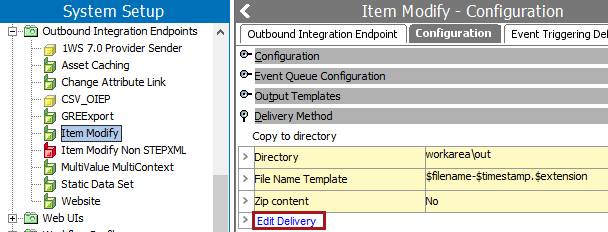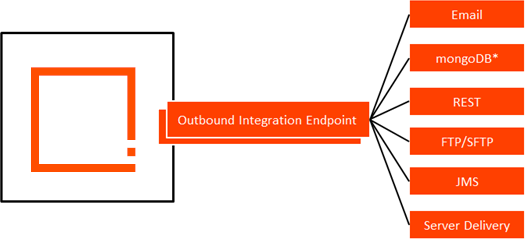The Delivery Method flipper in an OIEP includes the same parameters for both Event-Based and Select Objects endpoints. The delivery method controls how the output is delivered to an external system.
Open the Delivery Method flipper to display the selected delivery method. As shown below, the parameters vary based on the selected delivery method.

Delivery Methods
Delivery methods are used by both outbound data tools (Export Manager and OIEP) but the available options vary. For information on the delivery methods available in Export Manager, refer to Export Manager - Select Delivery Method here.
An OIEP takes the data determined by its configuration and delivers it using the selected delivery method to the downstream system or on a directory on the application server.

The following delivery method options are available (although some are based on a license) when exporting using an OIEP.
|
Method |
Description |
|---|---|
|
Amazon SQS |
Delivers messages to the Amazon SQS (Amazon Simple Queue Service). Refer to Amazon SQS Delivery Method documentation here. |
|
Azure Blob Storage Delivery |
Delivers files to Azure Blob Storage. Refer to Azure Blob Storage Delivery Method documentation here. |
|
Change Package Git Delivery |
Delivers change packages to a Git repository. Refer to the VCSI: Change Package Git Delivery Method in OIEP topic in the Configuration Management documentation here. |
|
Cloud Blob Storage Delivery |
Delivers exported files to cloud storage. Amazon S3, Google Cloud Storage, and Microsoft Azure are supported. Refer to Cloud Blob Storage Delivery Method documentation here. |
|
Copy to Directory |
Default selection for new OIEPs delivers files to a directory on the application server and allows the delivery to be zipped. Refer to Copy to Directory Delivery Method documentation here. |
|
Deploy |
Delivers files to a directory on the application server. Does not allow the delivery to be zipped. Refer to Deploy Delivery Method documentation here. |
|
Dynamic JMS |
The standard Dynamic JMS delivery options (Apache Active MQ, IBM MQ, and Oracle AQ) can be used to deliver messages to a Dynamic JMS Receiver without further customizations. Unlike the JMS delivery method mentioned above, this delivery method allows customers to supply the vendor-specific JMS libraries and JNDI configuration. Refer to the Dynamic JMS Delivery Method documentation here. |
|
|
Delivers files as an email attachment and allows a zipped delivery. Refer to Email Delivery Method documentation here. |
|
FTP |
Delivers files using file transfer protocol (FTP). Refer to FTP Delivery Method documentation here. |
|
Git Delivery |
Delivers files produced by the OIEP processing engine or a configured post-processor to a branch in a remote Git repository. Refer to the VCSI: Git Delivery Method in OIEP topic in the Configuration Management documentation here. |
|
The GDSN solution must be implemented fully before the GDSN Data Pool method is available and functional. Refer to GDSN Receiver Solution Enablement documentation here. |
|
|
GDSN Receiver Datapool |
The GDSN solution must be implemented fully before the GDSN Receiver Data Pool method is available and functional. Refer to GDSN Receiver Solution Enablement documentation here. |
|
IBM MQ SSL |
IBM MQ SSL, uses MQ series Secure Sockets Layer, and enables data exchange across IBM and non-IBM platforms. Refer to IBM MQ SSL Delivery Method documentation here. |
|
JDBC |
The JDBC delivery option enables delivery of data to RDBMS-type databases like Oracle, MySQL, MS SQL Server, PostgreSQL, etc. Refer to JDBC Delivery Method documentation here. |
|
JMS |
The standard JMS delivery options (Apache Active MQ, IBM MQ, and Oracle AQ) can be used to deliver messages to a JMS Receiver without further customizations. Refer to JMS Delivery Method documentation here. |
|
Kafka Delivery |
Apache Kafka is an open-source distributed event-streaming data platform. The Kafka delivery enables the STEP platform integrated with Apache Kafka to take advantage of built-in options for outbound processing to a Kafka queue. Refer to the Kafka Delivery Method documentation here. |
|
Mongo |
Receives data from a STEP event queue and loads it into a MongoDB database. The MongoDB is often used for website back-end, reporting, and high performance feeds to other back-end systems. Refer to Mongo Delivery Method documentation here. |
|
Oracle AQ |
Oracle Advanced Queuing (Oracle AQ) enables messages to be exchanged between two systems. Refer to Oracle AQ Delivery Method documentation here. |
|
Product Data Exchange 2 |
Product Data Exchange sends data to the Product Data Exchange (PDX) platform via the default PDX Outbound Integration Endpoint and the API. Refer to Product Data Exchange 2 Delivery Method documentation here. |
|
REST |
The REST Delivery Method delivers a call-back URL to the REST service and does not include actual STEP data. Refer to REST Delivery Method documentation here. |
|
REST Direct |
The REST Direct delivery method differs from the standard REST delivery method in that the data is delivered directly to the REST service and no call-back URL is required. Refer to REST Direct Delivery Method documentation here. |
|
SFTP |
Delivers a file using the Secure File Transfer Protocol (SFTP). Refer to SFTP Delivery Method documentation here. |
|
Wiki |
Delivers metadata to the metadata wiki platform. Refer to Wiki Delivery Method documentation here. |